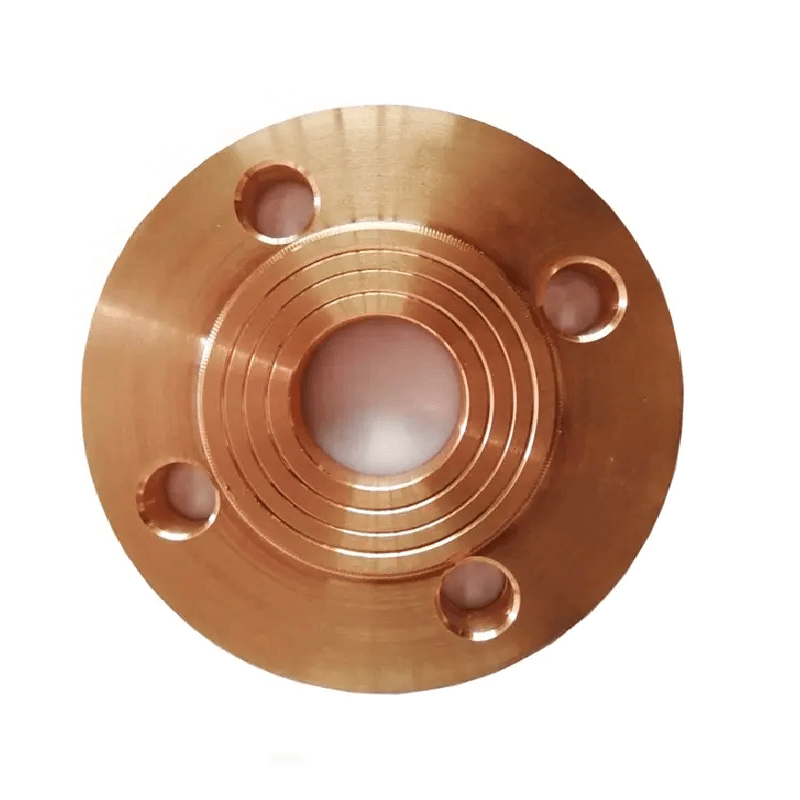Introducción a las mangas de brida de aleación de cobre
Las mangas de brida de aleación de cobre son componentes especializados ampliamente utilizados en varias industrias debido a sus propiedades excepcionales, que incluyen resistencia, resistencia a la corrosión y una excelente conductividad térmica y eléctrica. Estas mangas sirven como elementos críticos en aplicaciones mecánicas y estructurales, particularmente en contextos donde la integridad y el rendimiento de las articulaciones confiables son primordiales.

Comprender las aleaciones de cobre
Las aleaciones de cobre, hechas principalmente de cobre combinadas con otros metales como estaño, aluminio, níquel o zinc, exhiben propiedades mejoradas en comparación con el cobre puro. Estas mejoras pueden incluir una mayor resistencia mecánica, una mejor resistencia al desgaste y una mayor resistencia a la corrosión, lo que las hace ideales para entornos exigentes. Las aleaciones de cobre más comunes utilizadas para las mangas de brida son latón (aleación de cobre-zinc), bronce (aleación de cobre-tin) y bronce de aluminio (aleación de aluminio de cobre).
El papel de las mangas de la brida
Las mangas de brida son componentes cilíndricos diseñados para caber sobre una tubería o eje y a menudo se usan junto con accesorios con bridas. Proporcionan una articulación segura y estable, acomodando la expansión térmica, las vibraciones y otras tensiones mecánicas. Al usar materiales de aleación de cobre, estas mangas obtienen beneficios adicionales que mejoran el rendimiento del ensamblaje general.
- Resistencia a la corrosión: Aleaciones de cobre, particularmente bronce de aluminio, son reconocidos por su resistencia a la corrosión en ambientes marinos e industriales. Esta característica extiende significativamente la vida útil de la manga y los componentes conectados.
- Resistencia mecánica: Las mangas de brida de aleación de cobre mantienen propiedades mecánicas robustas a temperaturas y cargas variables. Esta resistencia es esencial para aplicaciones en sistemas de alta presión, como las tuberías de petróleo y gas, donde la confiabilidad es crítica.
- Conductividad térmica y eléctrica: Las aleaciones de cobre proporcionan una excelente conductividad térmica y eléctrica, lo que las hace adecuadas para aplicaciones en sistemas eléctricos e intercambiadores de calor.
- Facilidad de mecanizado: Muchas aleaciones de cobre son más fáciles de mecanizar que otros materiales, lo que permite una fabricación y personalización precisas para cumplir con requisitos de diseño específicos.
Aplicaciones de mangas de brida de aleación de cobre
Las mangas de brida de aleación de cobre se utilizan en una amplia gama de industrias, que incluyen:
- Petróleo y gas: En el sector de petróleo y gas, las mangas de brida son cruciales para mantener la integridad de los sistemas de tuberías, especialmente en aplicaciones en alta mar donde la resistencia a la corrosión del agua de mar es vital.
- Ingeniería Marina: Estas mangas se usan comúnmente en la construcción naval y las aplicaciones marinas, donde su resistencia y resistencia a la corrosión son indispensables para componentes expuestos a entornos de agua de mar duros.
- Generación de energía: En las centrales eléctricas, particularmente aquellas que utilizan intercambiadores de calor y sistemas de enfriamiento, las mangas de brida de aleación de cobre contribuyen a un manejo térmico eficiente y durabilidad.
- Sistemas HVAC: En los sistemas de calefacción, ventilación y aire acondicionado, las mangas de brida ayudan a garantizar conexiones confiables entre los conductos y las tuberías, manteniendo la eficiencia del sistema y la integridad.
Consideraciones de fabricación
El proceso de fabricación de las mangas de brida de aleación de cobre generalmente implica fundición, falsificación o mecanizado. La elección del método depende de las propiedades, dimensiones y volumen de producción deseados:
- Fundición: A menudo se usa para formas complejas, la fundición permite una producción en masa eficiente de mangas con diseños intrincados.
- Forjar: Este método mejora las propiedades mecánicas de la aleación a través de la deformación, lo que lo hace adecuado para aplicaciones de alta resistencia.
- Mecanizado: El mecanizado de precisión permite la producción de mangas personalizadas para especificaciones exactas, a menudo requeridas en aplicaciones especializadas.
Mantenimiento y vida útil
Las mangas de brida de aleación de cobre generalmente requieren un mantenimiento mínimo debido a sus propiedades resistentes a la corrosión. Se deben realizar inspecciones regulares para verificar el desgaste y cualquier signo de corrosión, especialmente en entornos donde las mangas están expuestas a productos químicos o temperaturas extremas. Con el cuidado adecuado, estas mangas pueden proporcionar un servicio confiable durante muchos años, asegurando el rendimiento a largo plazo de los sistemas conectados.
Conclusión
Las mangas de brida de aleación de cobre son componentes indispensables en una miríada de aplicaciones industriales. Sus propiedades superiores mecánicas y resistentes a la corrosión, combinadas con una excelente conductividad térmica y eléctrica, las convierten en una opción preferida en entornos donde el rendimiento y la confiabilidad son críticos. A medida que las industrias continúan evolucionando, la demanda de componentes de aleación de cobre de alta calidad, incluidas las mangas de brida, seguirá siendo sólida, impulsando la innovación y el desarrollo en las prácticas de ciencias y ingeniería de materiales. A través de avances continuos, el papel de las mangas de brida de aleación de cobre se expandirá, consolidando aún más su importancia en las soluciones modernas de fabricación e ingeniería.
